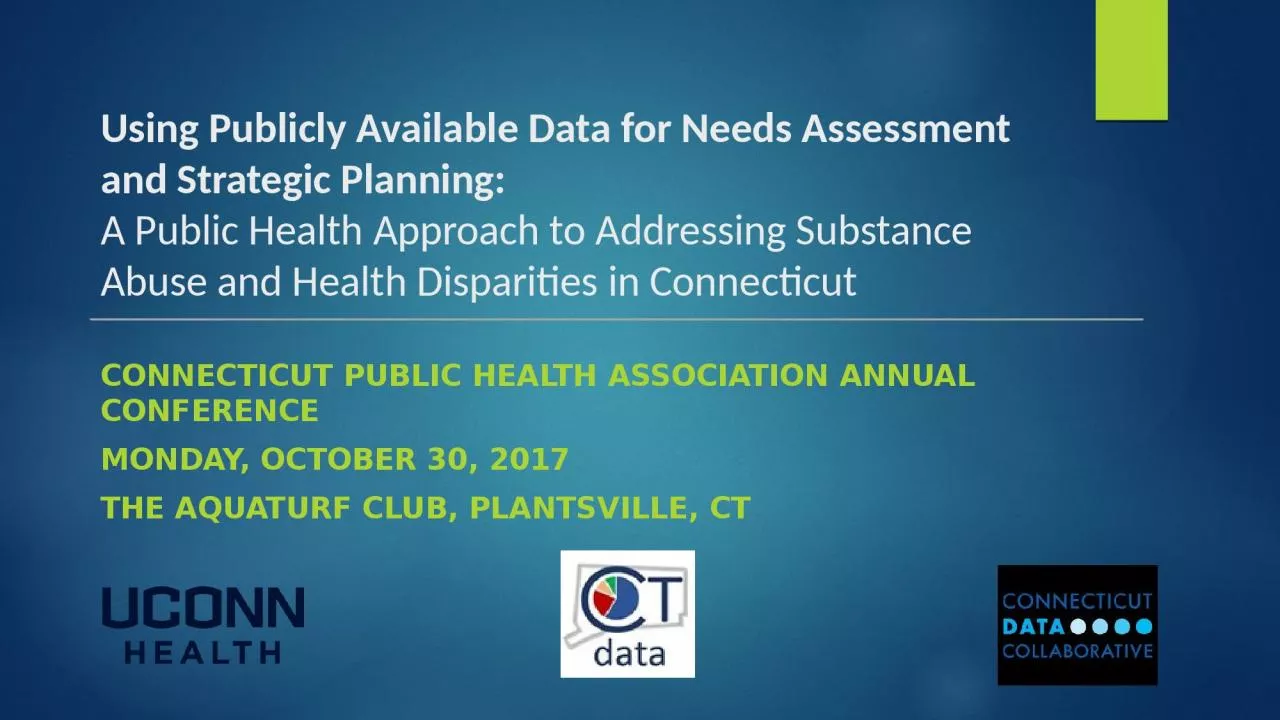

A Public Health Approach to Addressing Substance Abuse and Health Disparities in Connecticut Connecticut Public health association ANNUAL conference Monday October 30 2017 The Aquaturf club ID: 1045245
Download Presentation The PPT/PDF document "Using Publicly Available Data for Needs ..." is the property of its rightful owner. Permission is granted to download and print the materials on this web site for personal, non-commercial use only, and to display it on your personal computer provided you do not modify the materials and that you retain all copyright notices contained in the materials. By downloading content from our website, you accept the terms of this agreement.
1. Using Publicly Available Data for Needs Assessment and Strategic Planning: A Public Health Approach to Addressing Substance Abuse and Health Disparities in Connecticut Connecticut Public health association ANNUAL conferenceMonday, October 30, 2017 The Aquaturf club, PlaNTSville, CT
2. PresentersJennifer Sussman, BA, MFA, UCONN HealthCoordinator, DMHAS Center for Prevention Evaluation and Statistics (CPES)Michelle Riordan-Nold, MPPDirector, Executive Director, Connecticut Data CollaborativeTyler Kleykamp, Office of Policy and ManagementChief Data Officer, State of ConnecticutOpen Data Initiative
3. Learning ObjectivesParticipants will:Explore substance abuse as a public health issue, and how to use publicly available data to identify populations at greater risk of health disparities;Gain familiarity with publicly available data resources, including the State’s Open Data Portal, the Connecticut Data Collaborative website, the DMHAS Center for Prevention Evaluation and Statistics (CPES), and the State Epidemiological Outcomes Workgroup (SEOW);Learn about the challenges and limitations of compiling, sharing, and linking public health data, and the benefits of doing so for various constituencies and consumers.
4. How can public health data be used in addressing substance abuse?Substance Abuse DataMeasure the scope of the problemAssess magnitude, severity and impactPrioritize problems and risk factorsIdentify subpopulations Increase awareness, buy-in, and commitmentMeasure success/demonstrate valueSustain efforts (secure funding, etc.)Public Health DataLocate where the problem is most evident or likely to occurExplore characteristics of at-risk groups (subpopulations) Hone in on shared risk factors for substance abuseIdentify and address health disparities (individual, community)Assess community needs and resources, and access issuesTarget efforts and resources where they are most needed
5. Subpopulations and Health Disparities IndicatorsPopulation characteristicsPoverty rate / community economicsUnemployment rateCrime rateCommunity spending (education, health)Data on public health issues (obesity, disease, child maltreatment, etc.)Housing stability Food securityCommunity livability and equityCommunity connectedness Availability of servicesAccess to services Availability of transportation
6. Sources of Public Health DataCT Open Data Portalhttps://data.ct.gov/CT Data Collaborativehttp://ctdata.org/State Department of Education data (EdSight)http://edsight.ct.gov/SASPortal/main.doDepartment of Laborhttp://www1.ctdol.state.ct.us/lmi/laus/laustown.aspCT Crash Data Repositoryhttp://www.ctcrash.uconn.edu/CT Crime Data: Unified Crime Reporthttp://www.dpsdata.ct.gov/dps/ucr/ucr.aspxCT Census Data: CT State Data Centerhttp://ctsdc.uconn.edu/connecticut_census_data/Connecticut Economic Resource Center https://www.cerc.com/resources/town-profiles/
7. New Britain, Norwalk, and Norwich experienced a decline in number of teen births
8. 2015 Violent Crime (Rate per 100,000)Dataset on ctdata.org: UCR Crime Index3653342721,109944
9. 3 Towns experiencing lower unemployment rates but the rates in two towns (New Britain and Norwich) are consistently higher than the state averageDataset on ctdata.org: Labor Force
10. Residential Mobility can be an indicator of housing instability
11. Percent of Assisted Housing Units in 2016Dataset on ctdata.org: Subsidized Housing by TypeSource: CT Department of HousingAssisted includes: CHFA/USDA Mortgages, Deed restrictions, tenant rental assistance, and government assistedNew Britain18%Norwalk13%Hartford38%New Haven30%Norwich19%Windham30%
12. Opioid Related DMHAS Treatment AdmissionsData Source:https://data.ct.gov/Health-and-Human-Services/Opioid-Related-Treatment-Admissions-by-Town-in-Dep/4pv7-jhxb
13. DMHAS Treatment Admissions by Substance & YearNew BritainNorwichNorwalkData Source: https://data.ct.gov/Health-and-Human-Services/Admissions-to-DMHAS-Addiction-Treatment-by-Town-Ye/erbt-mpgb
14. Bus Stop Density andPharmacies that Dispense NaloxoneData Sources:Bus Stops: https://data.ct.gov/Transportation/CT-Transit-Hartford-New-Haven-New-Britain-Area-Rou/n4zd-qppb/Pharmacies: https://data.ct.gov/Public-Safety/Pharmacies-offering-Narcan-Evzio-and-other-brands-/2vby-9bet
15. Fire and EMS Data from the National Fire Incident Reporting SystemData Source: https://data.ct.gov/Public-Safety/Connecticut-Fire-Department-Incidents-2012-2015-/qem9-rt8k
16. What are the challenges of working with publicly available data?Suppression of data (small numbers)Rates provided but not numerators and denominators (population rates, etc.)Disaggregation's not provided or collected (race, gender, age)Some data may not encompass the entire population – Treatment data only reflects those admitted to State supported programsConsistent time frames – State data may be collected by Fiscal Year (July-June) rather than Calendar yearLack of standardized race/ethnicity categoriesErrors in dataData isn’t the story. You use data to help tell the story. –Brian Fanzo
17. Contact UsJennifer SussmanCoordinator, Center for Prevention Evaluation and Statistics (CPES) UConn Health Phone: (860) 679-5409 E-mail: sussman@uchc.eduMichelle Riordan-NoldExecutive Director, Connecticut Data CollaborativePhone: (860) 571-6214 E-mail: mrn@ctdata.orgTyler KleykampChief Data Officer, State of Connecticut Office of Policy & ManagementPhone:(860) 418-6302 E-mail: Tyler.Kleykamp@ct.gov